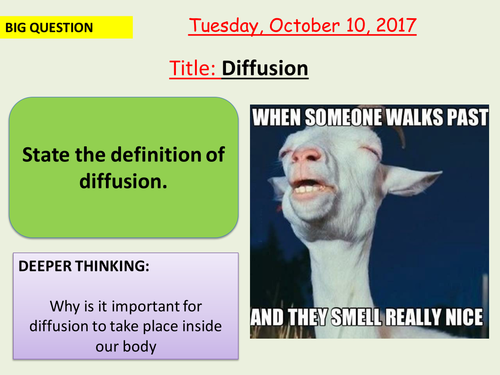

Diffusion lesson created in accordance to the NEW AQA Specification (9-1). Designed for a higher ability separates class, although content can be adjusted to suit any ability. Includes: slide animations, embedded videos and practice questions with answers on slides, worksheet. Due to the size of this topic, exchanging materials and surface area will be taught in a separate lesson.
AQA spec link: 4.1.3.1
Relevant chapter: B1 Cell structure and transport. AQA Biology third edition textbook-Page 14-15
Specification requires students to know the following;
Substances may move into and out of cells across the cell membranes
via diffusion.
Diffusion is the spreading out of the particles of any substance in solution, or particles of a gas, resulting in a net movement from an area of higher concentration to an area of lower concentration.
Some of the substances transported in and out of cells by diffusion are oxygen and carbon dioxide in gas exchange, and of the waste product urea from cells into the blood plasma for excretion in the kidney.
Students should be able to explain how different factors affect the rate
of diffusion.
Factors which affect the rate of diffusion are:
•• the difference in concentrations (concentration gradient)
•• the temperature
•• the surface area of the membrane.
AQA spec link: 4.1.3.1
Relevant chapter: B1 Cell structure and transport. AQA Biology third edition textbook-Page 14-15
Specification requires students to know the following;
Substances may move into and out of cells across the cell membranes
via diffusion.
Diffusion is the spreading out of the particles of any substance in solution, or particles of a gas, resulting in a net movement from an area of higher concentration to an area of lower concentration.
Some of the substances transported in and out of cells by diffusion are oxygen and carbon dioxide in gas exchange, and of the waste product urea from cells into the blood plasma for excretion in the kidney.
Students should be able to explain how different factors affect the rate
of diffusion.
Factors which affect the rate of diffusion are:
•• the difference in concentrations (concentration gradient)
•• the temperature
•• the surface area of the membrane.
Get this resource as part of a bundle and save up to 34%
A bundle is a package of resources grouped together to teach a particular topic, or a series of lessons, in one place.
Something went wrong, please try again later.
Report this resourceto let us know if it violates our terms and conditions.
Our customer service team will review your report and will be in touch.
£3.00
